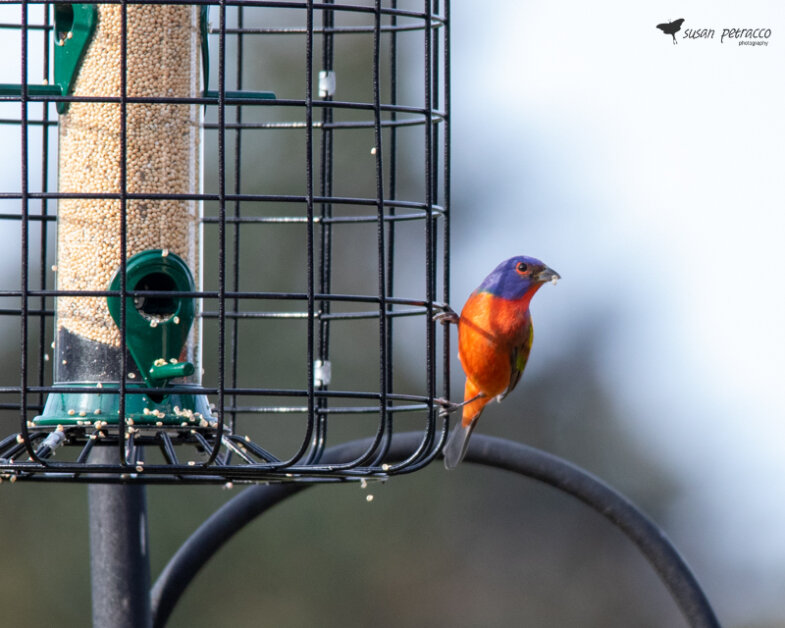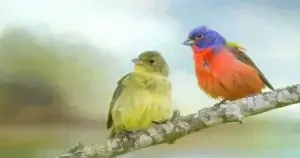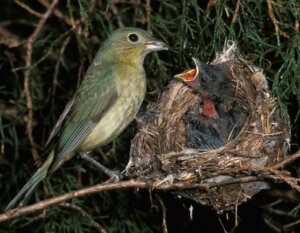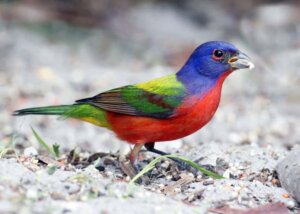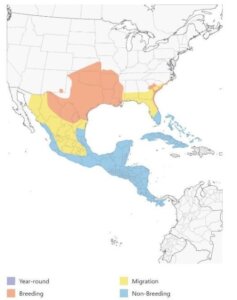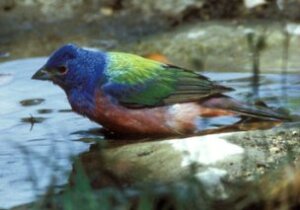How to Attract Painted Buntings: Ultimate Birdwatching Guide
Want to attract painted buntings to your backyard? These colorful birds bring joy and beauty.
Painted buntings, with their vibrant colors, are a sight to behold. Their striking appearance makes them a favorite among bird enthusiasts. But attracting these beautiful birds requires some effort and the right environment. They prefer specific habitats and food sources.
Creating an inviting space can help you enjoy their presence more often. Whether you’re an experienced bird watcher or a beginner, understanding their needs is key. In this guide, we’ll explore simple steps to make your yard a haven for painted buntings. From the best plants to the right feeders, we’ll cover it all. Get ready to welcome these stunning birds into your garden.
Introduction To Painted Buntings
The Painted Bunting, often called the most beautiful bird in North America, is a sight to behold. With their vibrant colors and melodic songs, they bring joy to bird enthusiasts. These small birds are a treat for the eyes, making them a favorite among birdwatchers.
Why Attract Painted Buntings
Attracting Painted Buntings to your garden has several benefits:
- Beauty: Their bright plumage adds a splash of color to your yard.
- Birdwatching: Watching these birds can be a relaxing and enjoyable hobby.
- Conservation: Helping these birds find food and shelter supports their population.
Unique Characteristics
Painted Buntings have several unique characteristics that make them stand out:
| Characteristic | Description |
|---|---|
| Plumage | Brightly colored feathers in red, blue, and green. |
| Size | Small birds, about 5 inches in length. |
| Song | Melodic and pleasant to hear. |
These birds are not just visually appealing. Their songs add a soothing ambiance to any garden.
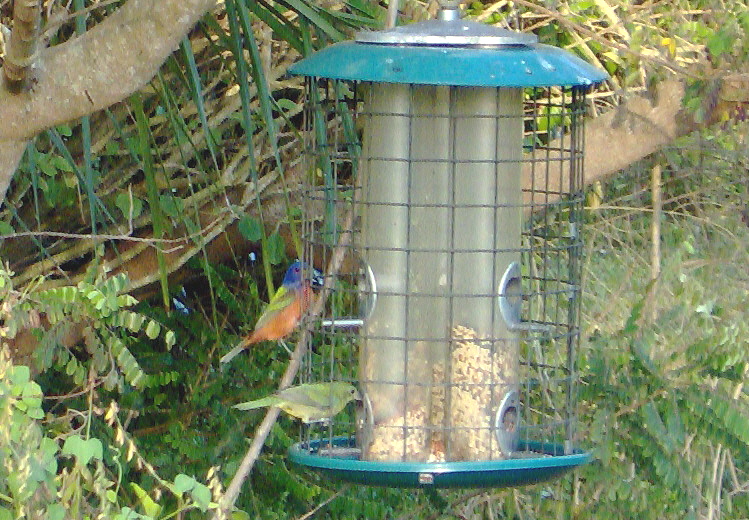
Credit: fairchildgarden.org
Ideal Habitat
Creating an ideal habitat for painted buntings can attract these colorful birds to your garden. Understanding their preferred environments and needs is the first step. Once you provide a suitable habitat, these birds will likely visit and even stay. This guide will help you create a perfect home for painted buntings.
Preferred Environments
Painted buntings thrive in areas with dense vegetation. They prefer regions with thick shrubs and tall grasses. These birds favor open woodlands and brushy fields. They also like edges of forests and overgrown pastures.
Their habitats are often near water sources. Streams, ponds, or birdbaths are good attractions. These elements provide drinking and bathing spots. Warm climates are ideal for painted buntings. They are usually found in the southern United States. Understanding these preferences helps in creating an inviting habitat.
Creating A Suitable Habitat
Start by planting native shrubs and grasses. They offer food and shelter to painted buntings. Berry-producing plants are excellent choices. Consider mulberry, elderberry, and dogwood. These plants provide food throughout the year.
Include dense bushes in your garden. They offer nesting sites and protection from predators. Suitable bushes are wax myrtle and sumac. Tall grasses like switchgrass add cover and nesting material.
Set up a water source, like a birdbath. Ensure it is shallow and clean. Moving water attracts more birds. A small fountain or dripper can help. Place the water source near vegetation for safety.
Provide feeders with seeds. Painted buntings enjoy millet and sunflower seeds. Use feeders with perches suited for small birds. Place feeders in sheltered areas to protect from wind and rain.
By creating a suitable habitat, you can enjoy the beauty of painted buntings in your garden. Follow these steps to create an inviting space for these vibrant birds.
Feeding Tips
Attracting Painted Buntings to your backyard can be a delightful experience. These vibrant birds are not only beautiful but also bring a sense of peace and nature to your surroundings. To make your yard appealing to them, focus on providing the right food and feeders. Below are some essential feeding tips to help you attract these colorful birds.
Favorite Foods
Painted Buntings have specific food preferences. Offering their favorite foods can increase the chances of them visiting your yard.
- White Millet: This is their top choice. They love the small seeds.
- Sunflower Seeds: Use hulled sunflower seeds. They are easier for the birds to eat.
- Niger Seeds: These tiny seeds are also a favorite.
- Safflower Seeds: Good for attracting Painted Buntings and deterring pests.
Providing a variety of these seeds will attract more birds.
Best Bird Feeders
The type of bird feeder you use is important. Painted Buntings prefer certain feeders over others.
| Feeder Type | Description |
|---|---|
| Tube Feeders | Ideal for small seeds like millet and niger. They are easy for the birds to perch on. |
| Hopper Feeders | These feeders can hold larger quantities of seeds. They protect seeds from the elements. |
| Platform Feeders | Good for mixed seeds. They allow multiple birds to feed at once. |
Place feeders in a quiet, sheltered area. This will make the birds feel safe. Clean the feeders regularly to prevent disease. With the right food and feeders, your yard can become a haven for Painted Buntings.

Credit: www.ecobeneficial.com
Nesting Areas
Attracting painted buntings to your garden involves creating inviting nesting areas. These colorful birds have specific nesting preferences. Providing safe nesting sites can make your garden a haven for them.
Nesting Preferences
Painted buntings prefer dense, shrubby areas for nesting. They favor low, bushy vegetation for protection and privacy. Native shrubs and thick grasses are ideal choices. These birds typically nest 3 to 6 feet off the ground. Create a natural, layered habitat with different plant heights. This encourages buntings to build their nests in your garden.
Providing Safe Nesting Sites
Safety is crucial for nesting painted buntings. Predators like cats, snakes, and larger birds pose threats. Place nesting sites away from high-traffic areas. Ensure the chosen spot offers cover and protection. You can use natural deterrents to keep predators away. Dense foliage and thorny plants can provide additional security.
Here are some tips for providing safe nesting sites:
- Plant native shrubs and grasses.
- Create layers of vegetation with different heights.
- Choose locations away from high-traffic areas.
- Use natural deterrents to protect from predators.
- Ensure the area provides cover and protection.
Following these guidelines helps painted buntings feel safe. This encourages them to nest and thrive in your garden.
Seasonal Considerations
Understanding the seasonal habits of Painted Buntings can help you attract them. These colorful birds have distinct patterns and preferences during different times of the year. By catering to these habits, you can increase your chances of seeing them in your garden.
Migration Patterns
Painted Buntings migrate between breeding and wintering grounds. They breed in the southeastern United States and winter in Central America. Their migration typically occurs from April to October. During these months, they seek out food, shelter, and water.
To attract them during migration, offer a variety of bird feeders. Use feeders that provide seeds, such as millet and sunflower seeds. Also, ensure your garden has dense shrubs and trees. These provide the cover and nesting sites they need. A birdbath with fresh water will also attract them.
Attracting Year-round
Creating a year-round haven for Painted Buntings involves more than just food. You need to provide a welcoming habitat. Native plants can offer natural food sources and shelter.
These plants can meet their needs throughout the year. Regularly maintain your feeders and birdbaths. This ensures they remain clean and inviting.
Below is a table summarizing key seasonal needs:
| Season | Key Needs |
|---|---|
| Spring | Food, Water, Nesting Sites |
| Summer | Food, Water, Shelter |
| Fall | Food, Water, Cover |
| Winter | Shelter, Water |
By understanding these seasonal considerations, you can create an environment that attracts Painted Buntings throughout the year. This will allow you to enjoy their vibrant colors and beautiful songs.
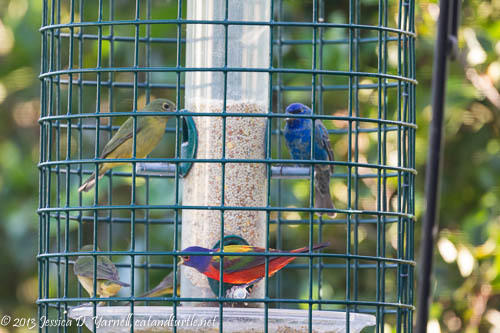
Credit: mtpleasant.wbu.com
Birdwatching Techniques
Birdwatching Techniques can make your experience of observing painted buntings much more enjoyable. Learning the right techniques helps in getting a better view of these colorful birds. It also increases your chances of spotting them in their natural habitat. Let’s delve into some effective techniques for birdwatching.
Optimal Viewing Times
Painted buntings are most active during the early morning. This is the best time to see them. They also come out in the late afternoon. During these times, the light is softer. It is easier to spot their bright colors. Avoid midday hours as birds rest during this time.
Using Binoculars And Cameras
Binoculars are essential for birdwatching. They help you see birds from a distance. Choose binoculars with a magnification of 8x or 10x. This range is ideal for observing painted buntings. Cameras with a good zoom are also useful. Capture their vibrant colors without disturbing them. Set your camera to a high shutter speed. This helps in getting clear shots of these fast-moving birds.
Frequently Asked Questions
How Do I Attract Painted Buntings To My Yard?
To attract painted buntings, provide dense shrubs for shelter and native plants for food. Install bird feeders with white millet seeds. Ensure a fresh water source like a birdbath.
What Kind Of Food Do Painted Buntings Eat?
Painted buntings primarily eat seeds, particularly white millet. They also enjoy insects and berries. Providing a variety ensures they visit your yard.
When Is The Best Time To See Painted Buntings?
Painted buntings are most visible during their breeding season, from late April to August. Early morning is the best time to spot them.
Where Do Painted Buntings Build Their Nests?
Painted buntings build nests in dense shrubs or low trees. They prefer secluded areas with ample cover and protection from predators.
Conclusion
Creating a vibrant haven for Painted Buntings is rewarding. Offer food, water, and shelter. Plant native shrubs and trees. These provide ideal nesting spots. Keep feeders clean and stocked. Provide fresh water daily. Avoid harmful pesticides. Enjoy watching these colorful birds visit.
With patience, your backyard can become their paradise. Happy birdwatching!
Hello Dear, I'm Poli Kolymnia, owner of many birds (including budgies).
With a deep passion for these feathered companions, I'm here to share my expertise and extensive knowledge on birds care.
My articles cover essential topics like diet, housing, care, and health, providing practical tips to help you create a happy and thriving environment for your birds.

